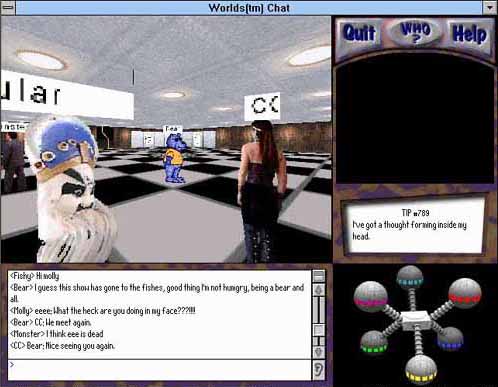
Article For: ACM Interactions, Design Column, September 1996
Author: Bruce Damer, Co-Director, Contact Consortium
Contact: our Webmaster
Length: Approximately 2500 words
Illustrations: 15
Introduction: Real Space comes to Cyberspace
In April of 1995 the Internet took a step into
the third dimension with the introduction of the Virtual Reality
Modeling Language (VRML) as a commercial standard. Another event
that month caused fewer headlines but in retrospect was just as
significant. A small company from San Francisco, Worlds Incorporated,
launched WorldsChat, a three dimensional environment allowing
any Internet user to don a digital costume, or avatar, and travel
about and converse with other people inhabiting the space. WorldsChat
was appropriately modeled on a space station complete with a central
hub, hallways, sliding doors, windows, and escalators to outlying
pods.

WorldsChat rapidly attracted a set of regular
inhabitants and sightseers who developed a culture to suit the
environment. At any time of the day or night, avatars could be
seen engaged in intense chat or careening around the station discovering
its passageways, rooms and secret tricks. For the first time,
there was "space" in Cyberspace and "visiting a
place on the Internet" began to have real meaning.
Worlds for many Tastes
In just the space of a year, an entire panacea of two and three dimensional inhabited graphical virtual worlds (now known simply as "worlds") has appeared on the Internet. Some of these worlds are designed to enhance the chat room experience: WorldsChat from Worlds, Inc., WorldsAway from CompuServe, V-Chat from Microsoft, ThePalace from Time-Warner Interactive, and Virtual Places from GNN and America Online. Other worlds focus on experimental development of the interactive version of VRML: PointWorld from Black Sun Interactive, Moondo from Intel, Utopia from Onlive! and many others. Another type of world has concentrated on enabling users to easily construct buildings and whole cityscapes: AlphaWorld from Worlds Inc., and the Terra Vista project. Lastly, numerous on-line multi-user gaming environments have appeared.
Visiting these worlds is easy, requiring a
minimum of an Internet dial-up connection and a reasonably fast
personal computer. After downloading and installing special client
software, the world can be entered, usually at no charge. Some
worlds run within on-line services and do not require a direct
Internet connection. The majority of these environments run on
Windows PCs but some are available for Macintosh or UNIX environments.
The author's organization, the Contact Consortium, maintains a
repository of worlds and a set of traveler's guides to these environments
on its web site at http://www.ccon.org.
Origins of Worlds
The worlds medium is the child of mixed heritage, including:
Chat is one of the most popular activities
on the Internet, running a close third to electronic mail and
browsing the World Wide Web. Following in the footsteps of Mosaic,
worlds transform the chat experience from a text-based experience
into a visual one. However, worlds have begun to evolve beyond
a mere chat enhancement into a collaborative, community building
environment.
HCI for the Masses
This new medium is exciting and the possibilities
for its use seem endless. Companies are now trying to design worlds
for retailing, virtual conferencing and project sharing. Educational
institutions are experimenting with worlds as learning environments.
In the next century, millions of people may enter worlds every
day to socialize, learn, work or be entertained. The medium will
be strengthened with the addition of voice, video, immersive headsets,
faster scene rendering and boosted Internet data rates. The worlds
medium could very well have the same impact on the Twenty First
Century as the telephone, radio, film and television had on the
Twentieth.
We believe that the worlds medium is the next
great frontier in interaction design and research. Perhaps the
best feature of the medium is that it allows, possibly for the
first time, ordinary home users with standard PCs and Internet
dial-up connections or on-line services to become interaction
designers and participate in collaborative exercises. Participants
in our organization's projects range from secondary school children
in Alabama to a rabbi in Israel. HCI specialists will have to
adapt to the fact that their discipline is suddenly of relevance
to a large number of people. The worlds medium will challenge
the HCI field to an extent inconceivable a few years ago.
The Contact Consortium: Life in Digital Space
The Contact Consortium was founded in March
of 1995 as a non-profit research and educational forum to enrich
the human experience within virtual worlds. Our membership includes
individuals possessing a wide range of expertise from the social
sciences, anthropology, engineering, the businesses hosting worlds,
computer scientists, and HCI specialists. We also count as participants
a large number of regular users of the Internet. The Consortium
holds large scale experiments within these environments to evaluate
their effectiveness for the world creators and to study and document
this unfolding phenomenon. Like scientists entering an experimental
biosphere, Consortium "cybernauts" don avatars and "live
in digital space" for extended time periods.
A key mission of the Consortium is to bring
the expertise of the HCI community into the worlds phenomenon.
We hope that the following two stories of design and interaction
in a virtual world will encourage many of you to participate in
this exciting new medium of human contact.
On May 8, 1996 at 10:00pm Central Standard Time, a young couple, Janka and Tomas, were wed inside the AlphaWorld virtual cityscape. This was not the first on-line wedding but it was the first to be held inside a three dimensional inhabited virtual world on the Internet. Preparations for the wedding took several weeks and included:
When the event was actually held, many coordinated actions from the participants were required to make it a success including:
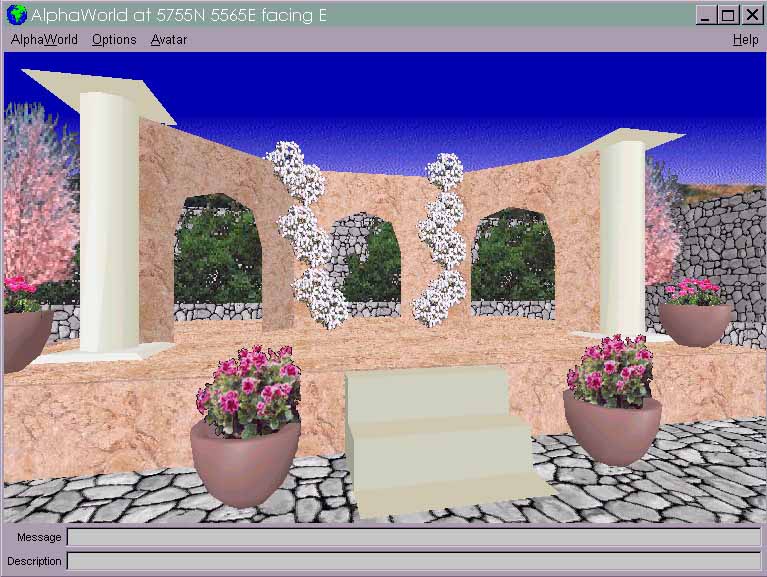
The stage and pavilion, designed by AlphaWorld citizen Laurel, was a work of skill, art and function. The space conveyed a bright, festive mood while being very practical for a virtual space event.
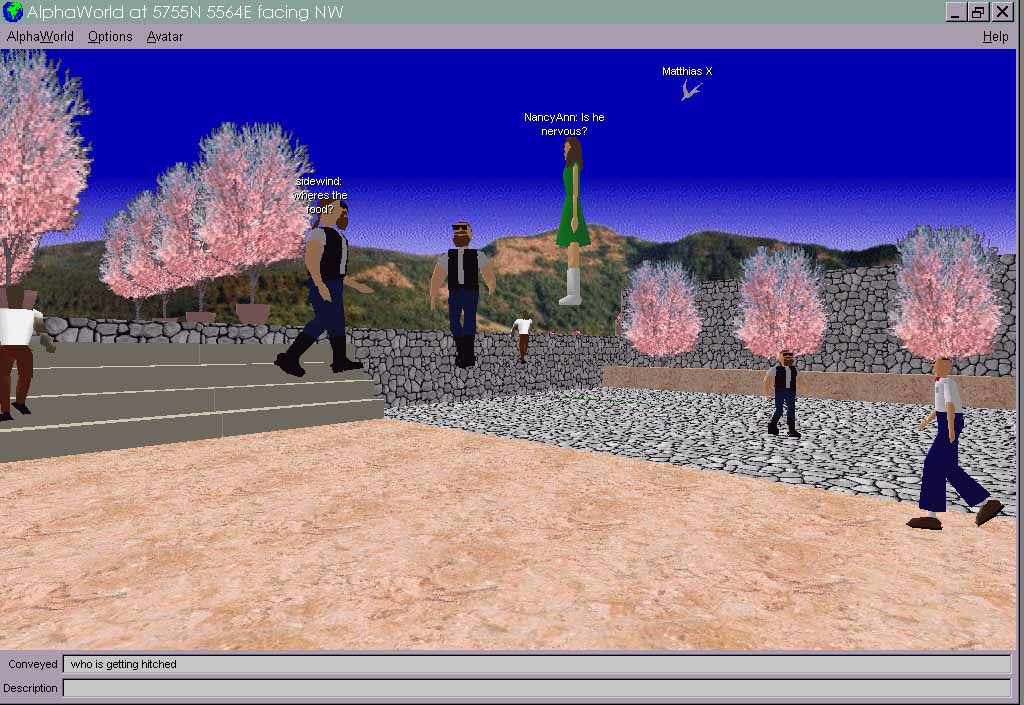
Users in avatar often prefer floating while conversing, as is seen here (the text chat is displayed over the heads of the conversants). Spaces for public events are therefore best designed as open to the sky.

The best man (Netguy) and groom (shown in black
tie avatars) with the bride (in white) and bridesmaid (Yellow
Rose) behind her, stand before the minister, who is positioned
on the stage.
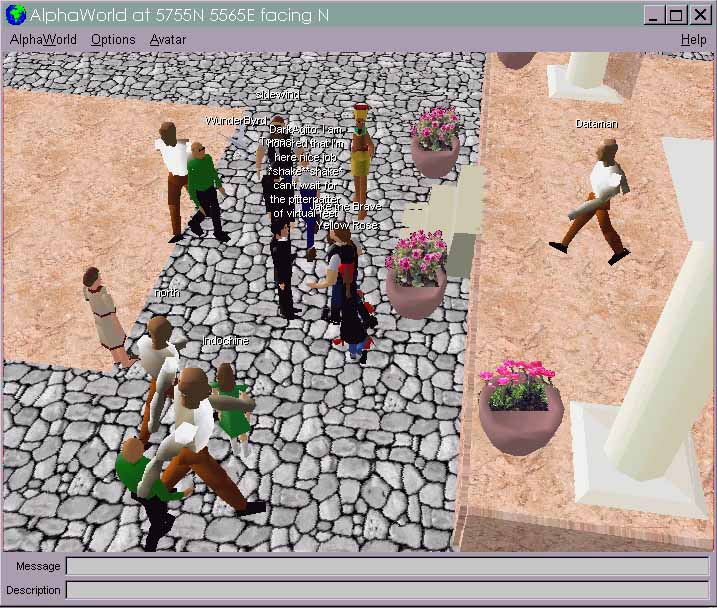
Seen in an overhead view, avatars rush in to
congratulate the couple. The text from the various voices crashes
together, along with the avatars themselves. It is not considered
rude to pass through someone in a virtual world.
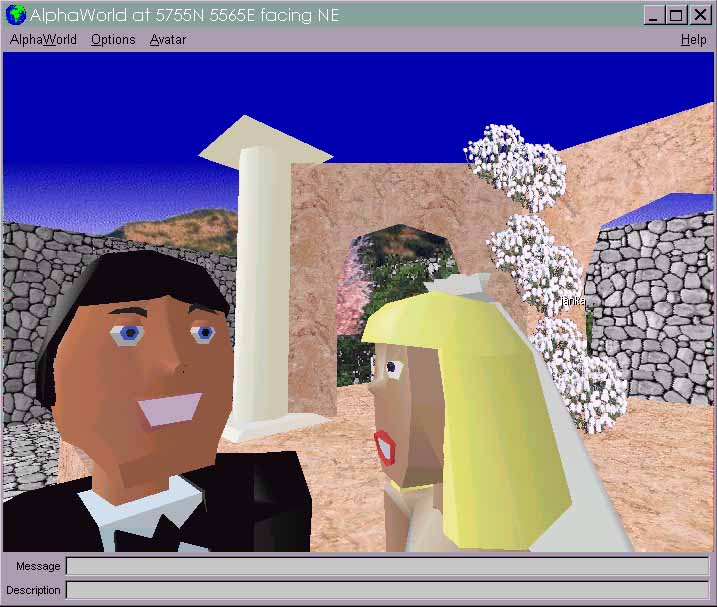
It took about 30 minutes to arrange for the
couple to pose for a photo (as it would with a real-place wedding).
Following the wedding, Tomas, who was in Texas, drove 3100 miles
to Tacoma, Washington to be with his bride. This was perhaps the
longest delayed "you may kiss the groom" in history!
The event lasted approximately 3 hours. The cognitive workload
of positioning oneself in a three dimensional environment while
conversing and not missing essential elements of the ceremony
was mentally taxing. However, Consortium participants agreed that
the wedding had the trappings of the real thing. We felt like
we had "been somewhere, and done something". For your
interest, the URL for Janka and Tomas is: http://www.best.com/~uvi/tomjanka.
The Contact Consortium was conceived back in
August 1994 as a forum for contact, culture and community in digital
space. By January of 1996, our dreams of constructing an inhabited
virtual community were about to come true. After six months of
testing virtual world environments, the Consortium determined
that AlphaWorld had evolved far enough to attempt a full scale
community design experiment.

Our goal was to go beyond the random "build
and abandon" activity characteristic of AlphaWorld and other
environments and create a virtual village which would have continuous
habitation. We selected an area within "walking distance"
of the main landing point in AlphaWorld, known as "ground
zero". This would allow us to easily guide new guests to
the site, and avoid having to go through "teleports"
which take citizens to distant sites.
In January 1996 we selected a site and carpeted it with a large forest, consisting of many species of trees, shrubs and flowers, all interspersed with lakes and streams. We wanted a natural setting in which to situate this new human community. Our goal was to create something aesthetically pleasing and incent builders to invest similar qualities into their constructions.

Next, we walled a large area to define the
town boundaries. We chose the catchy theme of the Sherwood Forest
of Robin Hood's time. On March 24, 1996 we held a town planning
meet inside the site. Participants from all over the world showed
up in response to our email broadcast. We tried out a cultural
interface innovation, a "talking circle" which would
allow more than two avatars to carry out a conversation. New members
joined the Sherwood community and many called for an unplanned
area where they could build outside our "community code".
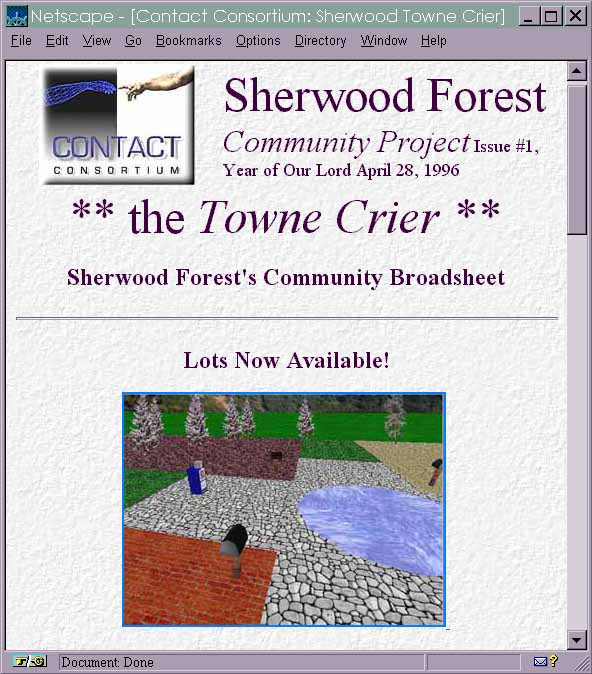
We had much work to do in preparation for the next event, which would be a build-in on May 4, 1996, including:

Starting on April 29, 1996 and right up through the build-in on May 4, lots were assigned and structures rose. On May 4, Consortium members met guests and community members in-world to help them with building and dealing with the zoning restrictions. Sherwood Town provides services such as access and easement, mailboxes (allowing neighbors to contact each other), site review, dispute resolution, a community newspaper and condemning of sites.
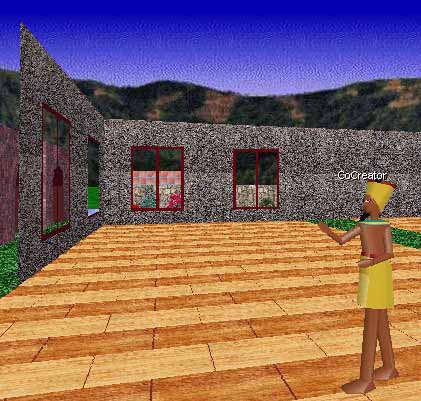
| 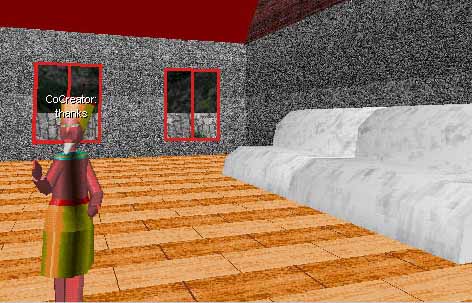
|
Steve Lankton, CoCreator in AlphaWorld and a world renowned psychotherapist, constructed a clinic for counseling, called Therapies 'R' Us, shown above. Steve was at work for eleven hours and opened Therapies for business at 10:00pm PST. We are not sure if he has had any clients yet but perhaps we will use the Therapies structure for dispute resolution!
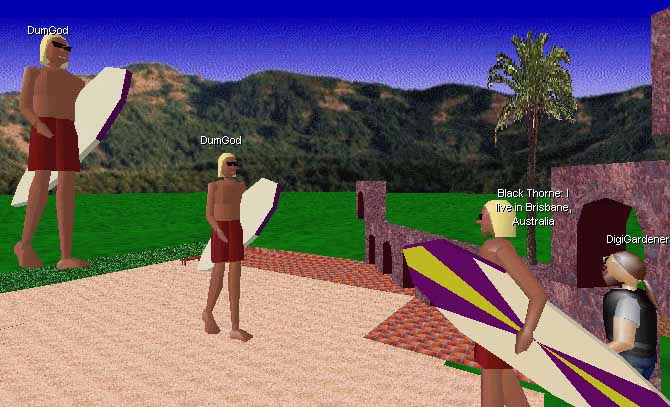
BlackThorne (Doug Goodier), a real surfer from
Brisbane, Australia and a master builder in AlphaWorld, toured
new arrivals around his high TechHut and gave lessons in building
and social interaction in the world. Two surfer avatars (13 year
old Brian Williams and his friend from Birmingham, Alabama) were
thrilled to meet Doug and showed up the next day for more building
instruction.

| 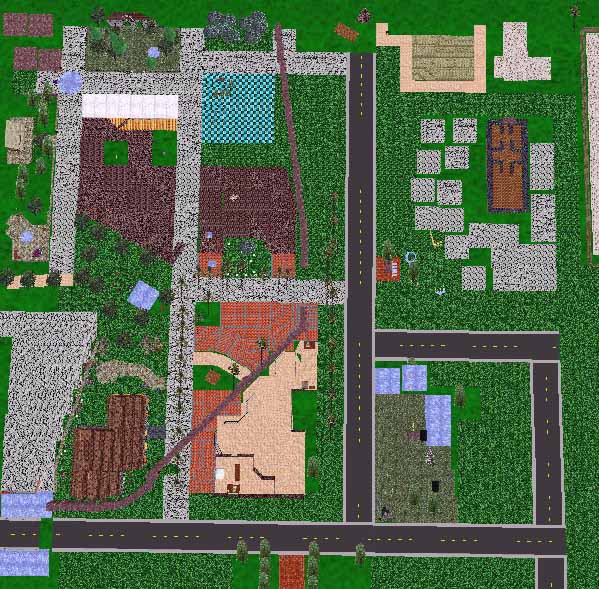
|
Our first town map and a subsequent high altitude
view of part of Sherwood townsite illustrates the rapid growth
of the area. We will be developing the New Towne area and including
in it a school of building and social interaction. We are developing
a mentoring program which will guide newcomers in the ways of
social interaction, navigation and building. In addition, an architect
from the United Kingdom is designing a school of virtual architecture
and a rabbi from Israel and a lay minister from the US will be
building sacred spaces. Additional plans call for a towne hall
and "pie in the sky" bakery and social gathering point.
We hope to keep drawing in guests and members to revisit Sherwood
Towne. Beyond Sherwood we plan an experiment called Mark I Asteroid.
We hope to implement this in VRML as an exercise in digital space
design and habitation outside the familiar metaphors of streets
and houses.
A Panacea of Worlds
AlphaWorld is only one of many virtual world environments hosted on the Internet. Virtual Reality Modeling Language (VRML) has evolved considerably in the past two years, recently acquiring advanced interactive facilities. Four VRML environments enabling habitation of avatars have come on-line in 1996: PointWorld from Black Sun Interactive, Moondo from Intel Corporation, Utopia from OnLive! and a world from Oz Interactive. In addition, several distributed VRML community building projects, such as Terra Vista, are in process. VRML worlds require users to build using a separate modeling system, as contrasted with the in-world building of AlphaWorld. VRML, however, allows users to define any shape or scene, as opposed to AlphaWorld's fixed set of textured objects. We expect that the realism and ease of use of the AlphaWorld environment will be adopted in the VRML environments.
On a different tangent altogether, two dimensional graphical chat worlds continue to evolve on their own path. Environments such as: thePalace from Time-Warner Interactive, Virtual Places from GNN and America Online, WorldsAway from Fujitsu Cultural Technologies and CompuServe, V-Chat from Microsoft and others are redefining the chat room experience. These environments are much more accessible to the average computer user, not requiring a knack for three dimensional navigation. Interface designers have been busy innovating in these environments: some offer simple emotional cues (a palette of happy and sad faces), some enable custom avatars for every user and some even offer tours of the web, with postage stamp avatars hugging a virtual rocketship.
All of these worlds are described in detail
and linked into the Consortium website at: http://www.ccon.org.
A New Frontier for Interaction Design
In our expeditions into multi-user virtual
worlds we have discovered that there is plenty of new ground to
be explored by the interaction designer and the entire CHI community.
Some of the new issues raised by the experiences described above
include:
Invitation: It is your world
We invite you to explore this medium with us.
We will be hosting numerous in-world experiments and real-place
conferences over the next several years and presenting results
at ACM CHI and other conferences. Please feel free to visit our
website at http://www.ccon.org or contact the author directly
through our Webmaster.
Acknowledgments:
The members of the Contact Consortium, the
VRML community and Worlds, Incorporated, AlphaWorld inhabitants
including the DigiGardener multivar, Silverthorne, CoCreator,
BlackThorne, DrumGod, Laurel, North, Dataman, NetGuy, Tomas, Janka
and many others too numerous to mention, and the members of the
CHI community for encouraging and supporting this article.
End.